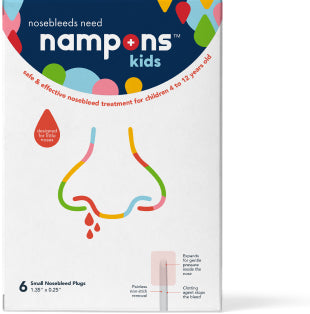Nosebleeds are common and rarely serious, and they are even more common in children. But that doesn't stop you from worrying when your child gets a nosebleed.
The question is, when do childhood nosebleeds stop being harmless and start being serious? How many nosebleeds are considered "too many"?
Let's find out.
When Should I Be Concerned About My Child's Nosebleed?
There are a few signs that suggest it's time to contact a doctor:
They Are Losing a Lot of Blood
Most nosebleeds stop after 10 minutes and result in very little blood loss. If your child's nose doesn't stop bleeding and they lose a lot of blood (a cup or more is considered a lot), it could be cause for concern.
Not only could it be indicative of a blood clotting issue, but it could also cause difficulty breathing, gagging, nausea, and vomiting as blood begins to flow down the throat.
Follow the usual instructions (ask them to sit down, lean slightly forward, and pinch the soft part of their nose for 10 minutes), and try again if that fails. If the bleeding doesn't stop after 30 minutes or they have lost a lot of blood, seek medical assistance.
They are Bleeding From Elsewhere
If your child is vomiting blood or coughing blood, it could indicate that they are losing too much blood or have another issue. In either case, it's worth taking them to the emergency room.
They Have Other Symptoms
Nosebleeds that occur as a result of nose-picking, nose-blowing, and a dry climate, rarely produce other symptoms. The child may feel a little lightheaded at the sight of the blood, and they may experience symptoms of panic/anxiety if the parent starts to worry and they feed off that anxiety. But generally, dizziness, headaches, sickness, fever, sweating, and pale skin could indicate something more serious.
It could be that they have contracted an infection or are suffering from anemia. There are many potential causes, all of which can be ruled out by a doctor.
They Have a Lot of Nosebleeds
Most of the time, when children experience frequent nosebleeds it's because they are susceptible to the dry climate or have a habit of picking their nose. But it could also be indicative of a more serious problem so it's best to get them checked.
Frequent nosebleeds can indicate everything from sinus infections and a deviated septum to bleeding disorders.
It's important not to worry, though. While frequent nosebleeds are usually more concerning than a single bleed, it's still a symptom that’s often explained away by innocuous causes.
They Suffered Head or Face Trauma
If your child was recently hit in the head playing sports, take them to the emergency room. Their nose might be bleeding from the trauma, but they may have also suffered from a concussion or a more serious injury.
How Many Nosebleeds a Week are too Many?
A nosebleed that occurs once or twice a week is likely the result of allergies, dry air, nose-picking, and other harmless issues.
One of the reasons that children experience nosebleeds more often than adults is that they pick and rub their noses more often. They are also more likely to stuff things in their noses.
The lining of the nose is very delicate and it doesn't take much for this to crack, rupturing the blood vessels underneath. As an adult, not only are you less likely to pick your nose, but you're more careful when you do it.
Children, however, tend to plunge their fingers inside like they're reaching for the toy at the bottom of a cereal box.
Watch your child's habits and pay attention to nose-picking and nose-blowing. If you notice them taking a lot of deep-fingered expeditions, try discouraging them while also trimming their nails.
If your child is experiencing 4 or more nosebleeds a week, consult with a healthcare provider.
There's still a high chance that the bleeding is caused by something as innocuous as dry air or nose-picking, but on the off-chance that it's something more serious, it's good to know sooner rather than later.
The doctor may run some tests and inspect your child's nose. They can prescribe nose drops, recommend a cool-mist humidifier, or simply advise them to use a saline nasal spray or some petroleum jelly.
Are Frequent Nosebleeds In Children Serious?
There are two types of nosebleeds: anterior nosebleeds and posterior nosebleeds.
Anterior nosebleeds happen in the front of the nose and occur when the delicate blood vessels rupture. The blood flows from one nostril and usually stops after 10 minutes. It's rarely heavy or serious and often results from direct damage, such as from nose-picking or dry air.
Posterior nosebleeds occur at the back of the nose and can be more serious. The blood can flow out of both nostrils and down the back of the throat, leading to nausea, vomiting, and breathing difficulties.
The type of nosebleed that your child experiences will give you a hint as to its potential cause and seriousness. However, regardless of the child's age or habits, it's important to remember that nosebleeds are common and are rarely a serious problem.
How Often Is Too Often For Nosebleeds?
Four or more nosebleeds a week could indicate more of an issue, but it doesn't necessarily suggest anything serious. Even chronic nosebleeds can have innocuous causes, such as bad nose-picking habits or dry nasal passages.
If it's difficult to stop the bleeding, it becomes more of an issue. In extreme cases, it could be indicative of a bleeding disorder. It's also more cause for concern if there are additional symptoms.
In any case, if you’re worried about your child's nosebleeds, get them checked over. It's always best to err on the side of caution where your child's health is concerned.



